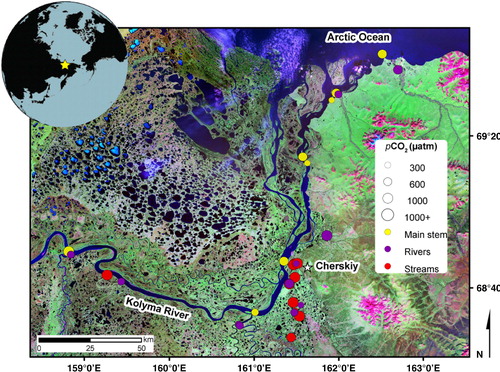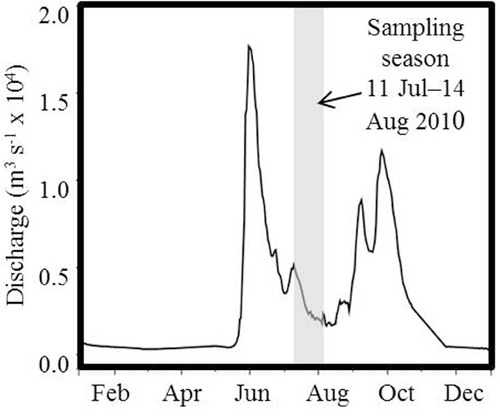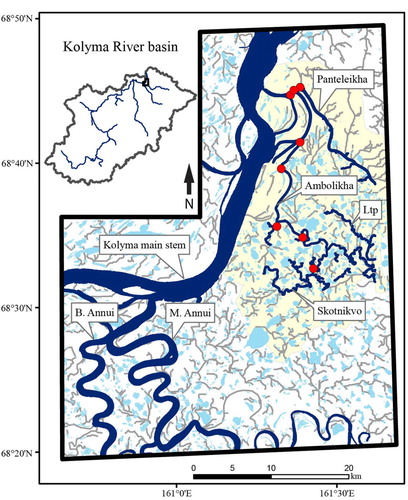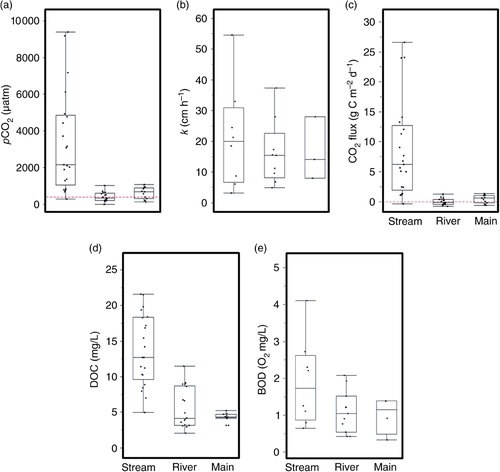Figures & data
Fig. 1 Field sample locations from 11 July to 14 August 2010. A total of 29 different sites were sampled (10 stream, 11 river and eight main stem locations), 14 of which were sampled two or more times (total n=56) spanning ca. 260 km along the Kolyma River main stem. Aquatic system types are colour coded, and streams and rivers were defined where reach length was <10 km and >10 km, respectively. Average pCO2 for each site is represented by varying circle size.

Table 1 Summary description of physical and biogeochemical characteristics of streams (<10 km reach length) and rivers (>10 km reach length) sampled in the northern Kolyma River basin during summer low-flow conditions.
Fig. 2 Daily discharge of the Kolyma River (adjusted to Cherskiy, Russia, ca. 160 km downstream of the gauging station at Kolymskoye) for 2010. The grey box indicates the sampling season of this study (11 July–14 August 2010), representing summer low-flow conditions.

Fig. 3 Bounded study area of the lower Kolyma River basin (black box). Areal coverage of surface water for a subset of sampled rivers and streams in the Kolyma River basin determined using four different types of satellite remotely sensed imagery (). Dark blue determined from pixel value histogram reclassification and light grey predicted from the ArcGISTM Hydrological Extension (). Light yellow area represents the portion of the Panteleikha–Ambolikha watershed covered by GeoEye imagery (30% of the total watershed areas; ). Red dots denote sampled stream locations. Lakes (light blue) were included for clarity.

Table 2 Summary of satellite imagery used to determine water surface area within the bounded study area.
Fig. 4 Comparison of (a) pCO2 (µatm), (b) k (cm hr−1), (c) CO2 flux (g C m−2 d−1), (d) dissolved organic carbon (DOC, in mg L−1) and (e) biological oxygen demand (BOD, in mg L−1) among streams (<10 km reach length), rivers (>10 km reach length) and the Kolyma main stem. Box plots show range, quartiles and median. The red dashed line in (a) represents 389.3 µatm, the mean 2010 atmospheric CO2 concentration during the sampling period (11 July–14 August 2010) and the red dashed line in (c) represents CO2 in equilibrium with the atmosphere (values above the line indicate a CO2 source and values below the line indicate a CO2 sink). Average k for streams, rivers and Kolyma main stem (21.2 cm hr−1, 16.2 cm hr−1, 16.7 cm hr−1, respectively) were used to calculate CO2 flux.

Table 3 Estimates of areal CO2 evasion fluxes from surface waters of the northern Kolyma River bounded study area (black box in ) during summer low-flow conditions.
Table 4 From a watershed perspective, estimates of CO2 evasion fluxes were scaled up to the Ambolikha–Panteleikha watershed during summer low-flow conditions.
Table 5 A summary of CO2 evasion fluxes from published studies of streams, rivers and main stem locations across different geographic regions in the Northern Hemisphere. Evasion estimates were adapted from the literature to be expressed as a loss of grams of C per m2 of water surface area per day. The selection includes studies for which daily evasion estimates were available (or could be readily calculated) for summer (June–August). CO2 evasion fluxes are recorded as a range and/or a mean of samples.